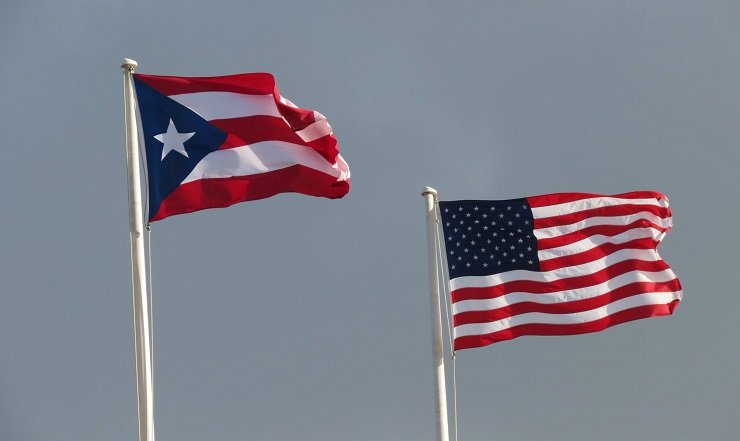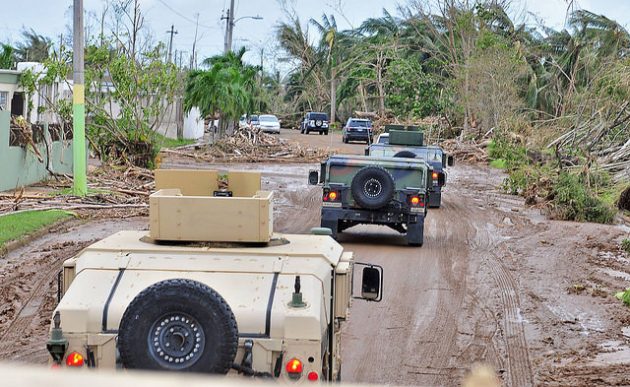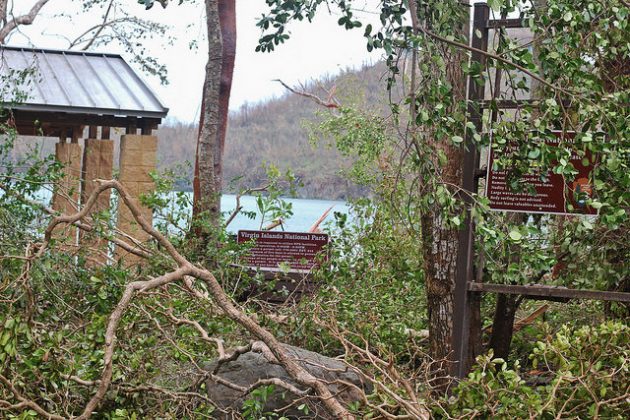
Hurricanes Irma and Maria recently caused devastating damage to the U.S. territories in the Caribbean: Puerto Rico and the U.S. Virgin Islands. Most residents are still without electricity and there was extensive damage to homes, buildings, and public infrastructure. Recovery and rebuilding will be long, difficult, and expensive. The human toll has been and continues to be staggering.
Residents of both territories are U.S. citizens (a fact is not widely known) and each territory has a (non-voting) delegate in the U.S. House of Representatives. The American flag has flown over Puerto Rico since 1898 and over the Virgin Islands since 1917.
Both territories were declared disaster areas by the president and numerous agencies of the federal government eventually lurched into action. The Federal Emergency Management Agency (FEMA) is managing the response. The Department of Defense and Coast Guard are supporting the efforts with ships, helicopters, personnel, and supplies. The National Guard has sent thousands of soldiers to help with security and other support missions. The Department of Transportation has helped to reopen airports and the Department of Energy has assisted with getting power plants back online.
This is all appropriate and necessary, as Puerto Ricans and U.S. Virgin Islanders are Americans, just like the Texans and Floridians who were also impacted by hurricanes this season.
Now that some of the immediate danger has passed and preliminary recovery is finally underway, it may be worth asking a comparatively trivial question: Why are Puerto Rico and the U.S. Virgin Islands not part of the American Birding Association’s ABA Area?
Both territories are part of the United States and the residents are American citizens, which appears to be the key criteria for inclusion. The addition of Hawaii eliminated any notion that the ABA Area is defined by geography or ecology and the inclusion of the territories of Washington D.C. and Midway Atoll means statehood cannot be a prerequisite. Moreover, Canadian provinces and territories are included in the ABA Area.
To the extent there is one, the primary animating principle appears to be that the ABA Area includes all of the United States and Canada. This makes sense: why should political subdivisions within a nation apply to a national birding organization?
After all, a birder living on the mainland can travel to the territories without a passport to go birding at a National Park (e.g., Virgin Islands NP) or National Wildlife Refuge (e.g., Cabo Rojo NWR) or a National Forest (e.g., El Yunque NF) to see an endemic bird listed under the Endangered Species Act (e.g., Yellow-shouldered Blackbird). This all happens without setting foot outside the U.S. because it is birding in the United States.
Perhaps Puerto Rico and the U.S Virgin Islands should be within the ABA Area. Maybe this tragedy is a good time to revisit boundaries of the ABA Area.
UPDATE: I make the case for adding Puerto Rico and the U.S. Virgin Islands to the ABA Area here.
# # #
Photos: Flags over San Juan by Jason Crotty; Assessing Damage by National Guard; Damage from Hurricane Irma to Virgin Islands NP by Eastern IMT.















While this argument is logical, it begs the question of Guam and the often-forgotten American Samoa.
Artifical geographcal divisions set up by a gang of a single species of ape cannot really be used to delimit ecological units.
Extreme southern Arizona is not a hot birding area not because the birds there are particularly scarce overall; many are common species in Mexico but merely “rare” in the artifical concepts known as the “ABA area” or the “United States of America”.
Great points both in this excellent post and the thoughtful comments. Adding Hawaii certainly changed the paradigm for what the ABA region was perceived to represent. Under an expanded definition, PR certainly qualifies as the next natural addition to the region.
On the other hand, if we add PR, Guam, and all the other satellite U.S. territories as representing an American bird zone, why keep Canada at all? If we keep Canada, why not add Mexico? Questions like the one Jason raises should spur further clarity regarding what the ABA region should real represent.
I agree 100% that the absence of any comprehensive established idea about the goal or purpose of the ABA Area hinders intelligent discussion about what the area “ought” to be. Is it political borders, ecological regions, tradition, or something else? My personal view is that the only defensible principle after Hawaii is political borders (the ABA is essentially the national birding association for the US and Canada) so it ought to include all of the territories, just like all Canadian territories are included.
Why stop at Hawaii? since the ABA area extend past the geographical boundaries of the North American continent, Let’s add the rest of the French country (since saint pierre et Miquelon is also part of the ABA). Plus the French territories themselves, obviously….
There’s an active discussion about this issue on the ABA’s Facebook page:
https://www.facebook.com/groups/ABAbirds/
The ABA should include everything down to Panama.
Why add Puerto Rico if you are not going to add the other Caribbean Islands?
As the article says, because they are Americans. The other Caribbean islands are not.
ABA President Jeff Gordon discusses the ABA Area on the ABA podcast. Obviously worth listening to and it is the last segment (at about 23:47).
http://blog.aba.org/2017/10/american-birding-podcast-the-importance-of-the-farm-bill-with-amanda-rodewald.html
Imagine what an influx of birders from the US could do to a country like Puerto Rico. The economic boost alone would truly benefit all the people that live there. It would probably even motivate more people to contribute to the reforestation and rebuilding of the area. Bring on PR!!!